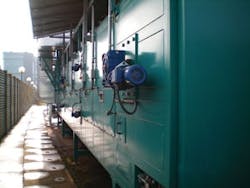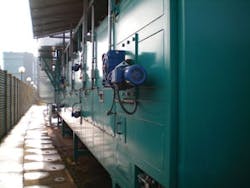The City of Auburn, IN, discovered that consistent agitation was needed in a sludge storage tank to insure proper sludge feed to the plant's belt press. Without good mixing, solids and debris settled to the bottom of the tank and compromised pumping efficiency. The plant initially used a jet-mixing pump to maintain consistent agitation in the tank but recurring clogs created a bottleneck.
With a population of 13,000, Auburn is among many municipalities across the nation operating conventional activated sludge secondary WWTP facilities. Located within commuting distance north of Fort Wayne, the municipal utility's six-square-mile service area has historically experienced pronounced peak flows caused by nearly one-fourth of its collection system consisting of combined stormwater and sanitary sewer lines.
This was a significant design consideration when the municipal utility embarked on the Plant #2 project to cope with peak flows. Plant #2 was designed as a 2 mgd facility that can handle up to 5 mgd peaks. As part of the same project, portions of the older vintage Plant #1 were refurbished to achieve a capacity of 2.5 mgd at normal flow and up to 4 mgd during peaks. The combined peak capacity for the two plants now stands at the 9 mgd.
Replacement Flygt Jet Mixers operate on a dry-mount and deliver consistent mixing in the bolted steel tank holding the sludge.
Plant #2 has a six-stage process chain, including preliminary treatment using grinder pumps and two mechanically cleaned bar screens to reduce the size of large solids in the influent that might cause downline jams.
While the six-stage process at Plant #2 delivers a good quality effluent, the sludge handling portion of the plant's process chain presented a weak link.
The pump used to mix sludge in the 186,500-gallon holding tank just ahead of the dewatering press repeatedly clogged. Without agitation, this would cause the solids to settle toward the bottom of the tank and made it harder to run through the belt press.
The clogging was further aggravated when contract haulers brought solids from the area's package plants and dumped it directly into the holding tank. Either situation allowed inconsistently mixed sludge to reach the point where polymer coagulant was injected approximately 10 feet ahead of the belt press.
New Pumps
To counter the problem, Auburn installed new Flygt N-Pumps. The clog-resistant N-type pumps are designed to handle concentrated solids in difficult applications. They have been adapted for use with Flygt Jet Aerators.
The secret to their performance resides in a geometrically advanced impeller and wear ring design that prevents rags, fibrous or other material from accumulating on the impeller's leading edges, which prevents clogging and loss of performance. N-Pumps also have a record of reduced maintenance costs and typically operate at significantly lower energy costs than conventional pumps.
In the Auburn application, the replacement pumps required no special housing or superstructure. The two clog-prone units were merely pulled and replaced with the ITT Water and Wastewater pumps in a dry-mount configuration.
When configured for jet mixing, as applied to the Auburn plant, the swept-back leading edge of the impeller and a relief groove in the volute of the N-type units inherently resist clogs by easing the passage of any stubborn material that reaches the raw sludge holding tank. As the impeller turns, suspended fibrous material and any solids drawn into the pump suction are spun outward to the discharge where it is then flushed away.
The innovative impeller is a geometric improvement over the axial leading edge of most impellers. Axial edges present an ideal shape for entangling rags and other long stringy material. ITT research established 70% as the highest efficiency value for a typical single-vane pump in a best-specific-speed range. The N-pumps deliver 80% or higher efficiency which equates to 15% less power consumption and significant savings over the course of a year.
Although the pumps are available with an integrated monitoring and schedule control system, Auburn opted for manual control since the mixing units operate 24/7 without any off-line periods.
The frequent clogging experienced with the former pumps is now just an unpleasant memory. The Flygt units have operated reliably without the frequent clogs that previously imposed downtime.
More WaterWorld Current Issue Articles
More WaterWorld Archives Issue Articles




